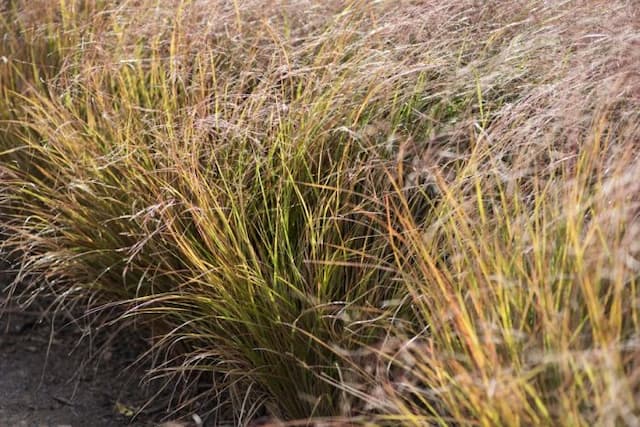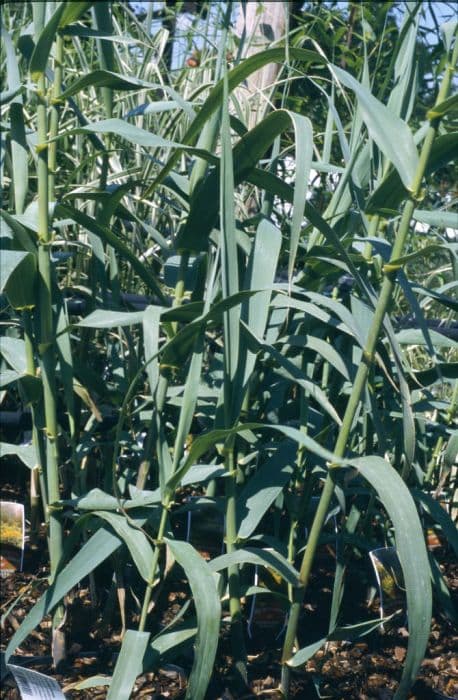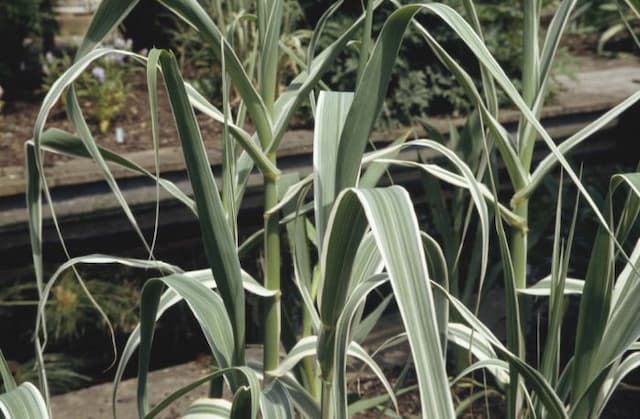Maiden Grass Miscanthus sinensis 'Rotsilber'











ABOUT
Japanese Silver Grass 'Rotsilber', an ornamental grass known for its graceful appearance, features a fountain of slender leaves that arch outward from the center of the plant creating a rounded shape. The foliage is deep green with a silver midrib that can catch the light, contributing to its visual interest. During the later summer to the fall season, feathery plumes emerge, starting with red tinges before turning silvery as they mature. These airy plumes stand above the foliage, providing a contrasting texture and movement when swayed by the breeze. The whole plant possesses an elegance that can add both visual and auditory appeal to gardens, as the leaves rustle softly in the wind.
About this plant
 Names
NamesFamily
Poaceae.
Synonyms
Silver Feather Grass, Red-silver Maiden Grass, Rotsilber Maiden Grass.
Common names
Miscanthus sinensis 'Rotsilber'.
 Toxicity
ToxicityTo humans
Maiden Grass is generally not considered toxic to humans. There are no known toxic effects from ingesting any part of the plant, and it is usually regarded as safe in gardens and landscaping where human contact is likely.
To pets
Maiden Grass is also not known to be toxic to pets. There are no significant symptoms of poisoning associated with the ingestion of this plant by animals, and it is generally considered pet-friendly in a garden setting.
 Characteristics
CharacteristicsLife cycle
Perennials
Foliage type
Deciduous
Color of leaves
Green
Flower color
Reddish
Height
4-7 feet (1.2-2.1 meters)
Spread
3-5 feet (0.9-1.5 meters)
Plant type
Grass
Hardiness zones
5-9
Native area
Asia
Benefits
 General Benefits
General Benefits- Ornamental Interest: Miscanthus sinensis 'Rotsilber', commonly known as Maiden Grass, offers aesthetic appeal with its silver-pink plumes and graceful foliage that sways in the wind.
- Seasonal Color: It provides visual interest through changing seasons with its foliage that transitions from green in spring and summer to copper, beige, and silver in fall and winter.
- Drought Tolerance: Once established, Maiden Grass is known for its ability to withstand periods of low water availability, making it suitable for xeriscaping.
- Erosion Control: The dense root system of Miscanthus sinensis 'Rotsilber' helps stabilize soil and prevent erosion on slopes or banks.
- Low Maintenance: Maiden Grass requires minimal care once established, needing only occasional watering, annual trimming, and almost no fertilization.
- Wildlife Habitat: While not a primary food source, the plant can offer habitat to birds and insects, which use it for cover and nesting.
- Privacy Screening: It can be planted in groups to form an effective visual screen or windbreak, providing privacy and reducing wind in gardens and landscapes.
- Hardiness: Maiden Grass is adaptable to a range of climatic conditions, being hardy in USDA zones 5 through 9.
- Soil Adaptability: It can thrive in a variety of soil types, though it prefers well-drained soil; it is relatively tolerant of poor soils once established.
- Versatility in Landscaping: The plant can be used in mass plantings, as a specimen plant, or incorporated into borders and foundation plantings for texture and contrast.
 Medical Properties
Medical PropertiesThis plant is not used for medical purposes.
 Air-purifying Qualities
Air-purifying QualitiesThis plant is not specifically known for air purifying qualities.
 Other Uses
Other Uses- Maiden grass (Miscanthus sinensis 'Rotsilber') can be used as a natural privacy screen or garden border due to its height and dense foliage.
- The dried leaves and plumes of maiden grass can be used in floral arrangements or as a part of wreaths, bringing a touch of nature indoors.
- It can serve as a sound barrier when planted in dense rows, muffling noise from roads or neighbors.
- The fibrous material of the grass can be used in paper making, providing an alternative to traditional wood pulp.
- Miscanthus is being researched for its potential as a biofuel, as it can be fermented to produce ethanol and other fuels.
- The plant can be woven into mats or screens, an eco-friendly material for interior design or practical uses like shading.
- Maiden grass can be used to assist with soil erosion control, as its robust root system helps stabilize the ground.
- Used in landscape design to create movement and texture, its leaves and plumes sway beautifully in the wind.
- The tall and striking appearance of the grass can be used in art installations or as natural sculptures in garden displays.
- As a cover crop in agriculture or gardening, maiden grass can help suppress weeds and improve soil health during the off-season.
Interesting Facts
 Feng Shui
Feng ShuiThe Maiden Grass is not used in Feng Shui practice.
 Zodiac Sign Compitability
Zodiac Sign CompitabilityThe Maiden Grass is not used in astrology practice.
 Plant Symbolism
Plant Symbolism- Resilience: Miscanthus sinensis, commonly known as maiden grass, showcases resilience through its ability to thrive in various soil types and to withstand strong winds and cold climates.
- Adaptability: The ease at which maiden grass adjusts to different environments symbolizes the capacity to adapt to diverse life situations.
- Privacy: Often used as a screen or hedge in landscaping, maiden grass represents the need for personal space and the respect for privacy.
- Elegance: With its fine foliage and graceful plumes that catch the light, maiden grass embodies elegance and sophistication.
- Growth: As a perennial that returns each year with renewed vigor, maiden grass symbolizes continual growth and renewal.
- Boundaries: The clumping nature of maiden grass and how it can define edges in a garden symbolizes the importance of setting and respecting boundaries.
 Water
WaterMaiden Grass should be watered deeply once a week, ensuring that the soil is soaked but not waterlogged. During the active growing season in spring and summer, you may need to water more frequently, especially if the weather is particularly hot or dry. Aim for about 1 to 1.5 inches of water per week, whether from rainfall or manual watering. In fall and winter, reduce the frequency of watering as the plant's growth slows down. Ensure that the soil remains slightly moist, but let it dry out between waterings to prevent root rot.
 Light
LightMaiden Grass thrives best in full sun, receiving at least 6 hours of direct sunlight daily. This grass can also tolerate partial shade, but its growth may not be as robust and flowering might be less prolific. The ideal spot should be an area that gets unfiltered sun for most of the day, as this plant loves light and warmth to reach its full potential.
 Temperature
TemperatureMaiden Grass is hardy and can tolerate temperatures down to about -20 degrees Fahrenheit but thrives in temperatures between 50 to 90 degrees Fahrenheit. It is suitable for USDA zones 5 to 9. Ensure that the grass is well-mulched in winter to protect its roots from extreme cold.
 Pruning
PruningPrune Maiden Grass during late winter or early spring before new growth begins. The purpose of pruning is to remove old foliage and make way for new growth, which keeps the plant looking tidy and encourages a healthy, dense form. Cut the grass back to about 4 to 6 inches above the ground annually. This timing allows you to enjoy the plant’s winter interest before cutting it back.
 Cleaning
CleaningAs needed
 Soil
SoilMaidenhair Grass 'Rotsilber' thrives in well-drained, fertile soil with a pH ranging from 5.5 to 7.5. A mix of loamy soil, peat, and sand in equal proportions is ideal to facilitate good drainage and provide essential nutrients.
 Repotting
RepottingMaidenhair Grass 'Rotsilber' doesn't frequently need repotting as it's a large grass. Division and repotting can occur every 3-5 years to manage its growth and invigorate the plant.
 Humidity & Misting
Humidity & MistingMaidenhair Grass 'Rotsilber' tolerates a wide range of humidity levels but prefers average to high humidity. It is quite adaptable to outdoor conditions.
 Suitable locations
Suitable locationsIndoor
Place in bright light, allow space, keep moist.
Outdoor
Full sun to partial shade; well-drained soil.
Hardiness zone
5-9 USDA
 Life cycle
Life cycleMiscanthus sinensis 'Rotsilber', commonly known as Silver Feather Maiden Grass, begins its life cycle as a seed which germinates in warm spring soil. Once the seedling emerges, it enters a period of rapid vegetative growth, developing long, arching grass blades with silver-red plumes as it matures. During the summer, the plant reaches full size and its feather-like flowers bloom, adding visual interest to the landscape. As autumn approaches, the foliage may take on bronze or reddish hues before entering a state of dormancy in winter, where the above-ground part of the plant dies back after frosts. In the dormant stage, Silver Feather Maiden Grass conserves energy in its rhizomes, which are underground stems that store resources for the next growing season. With the arrival of spring, new growth resumes from these rhizomes, repeating the life cycle.
 Propogation
PropogationPropogation time
Late Summer
The most popular method of propagating Miscanthus sinensis 'Rotsilber', commonly known as Maiden Grass, is through division. This is typically done in the spring as the plant emerges from dormancy. To propagate by division, the gardener should dig up the entire clump of the mature grass with a shovel and then either pull apart the roots by hand or use a sharp knife to slice through the dense root ball. It's important to ensure that each division has a section of the roots and several shoots for best results. These new divisions can then be replanted immediately at the same depth they were originally growing, and watered thoroughly to help establish the new plants. Since Maiden Grass can have a large root system, dividing every few years also helps rejuvenate the plant and control its size in the landscape.









